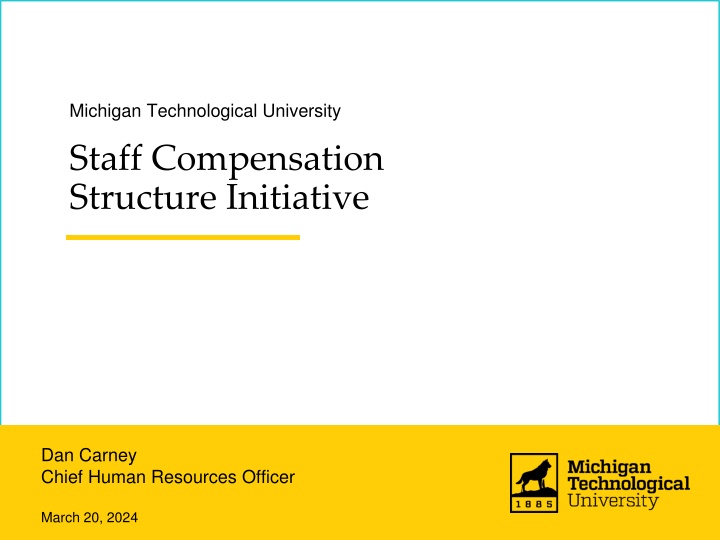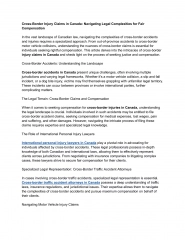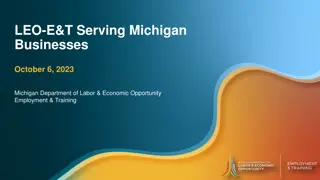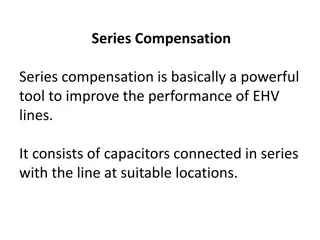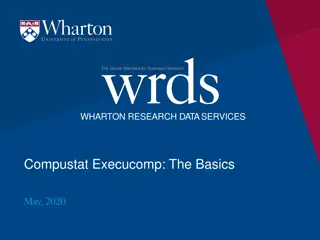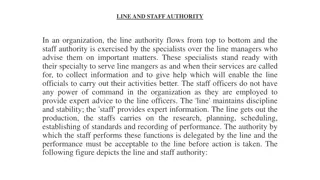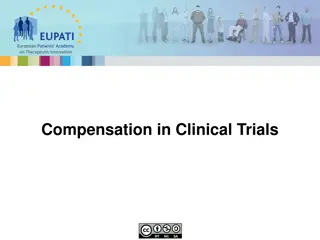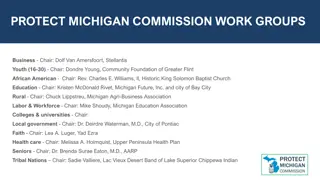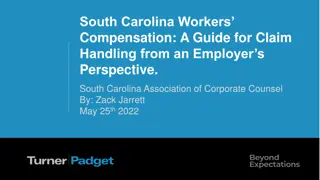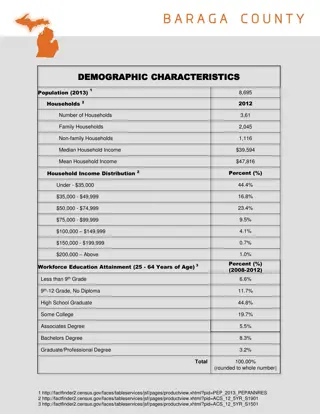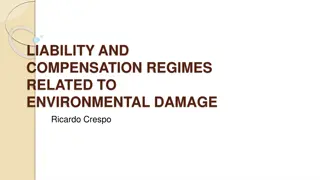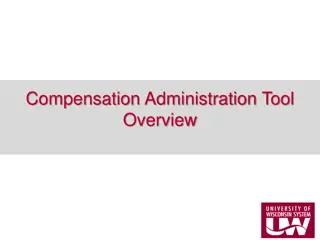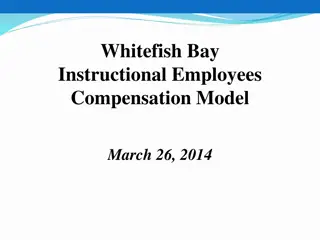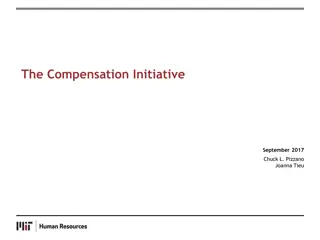Michigan Tech Staff Compensation Structure Initiative Overview
Michigan Technological University is implementing a new staff compensation structure initiative to enhance talent attraction, retention, and support. The current approach is outdated, leading to inconsistencies and challenges. The initiative involves partnering with a consulting firm, updating job classification, establishing pay ranges, and improving pay administration to align with strategic goals.
Download Presentation

Please find below an Image/Link to download the presentation.
The content on the website is provided AS IS for your information and personal use only. It may not be sold, licensed, or shared on other websites without obtaining consent from the author.If you encounter any issues during the download, it is possible that the publisher has removed the file from their server.
You are allowed to download the files provided on this website for personal or commercial use, subject to the condition that they are used lawfully. All files are the property of their respective owners.
The content on the website is provided AS IS for your information and personal use only. It may not be sold, licensed, or shared on other websites without obtaining consent from the author.
E N D
Presentation Transcript
Michigan Technological University Staff Compensation Structure Initiative Dan Carney Chief Human Resources Officer March 20, 2024
Why is a Robust Compensation Structure Needed for Staff at Michigan Tech? It s About Our People. It is our people who make Michigan Tech so special and who drive the fulfillment of our institutional mission and strategic growth. One of the highest priorities in our strategic framework is a focus on strengthening institutional capacity and enhancing our ability to attract, retain, and support exceptional talent. Current State. Our current approach to Staff pay delivery is not aligned with contemporary practice, making it difficult to attract and retain the talent we need to achieve our institutional priorities. Having no unified pay structure and a decentralized pay administration, there are often inconsistencies in pay decisions, potential pay disparities, lack of career progression clarity, poor employee morale, and ineffective recruitment and employee retention. Future State. With a robust pay structure in place, a modern governance framework will be used to support a new job classification plan and pay structure. This framework will also ensure consistent pay administration by providing a consultative and approval role within Human Resources. The updated compensation structure will improve our ability to attract and retain the talent Michigan Tech needs. 1
Staff Compensation Structure Initiative - Phases Michigan Tech has partnered with Segal Company, a human resources consulting firm with an extensive portfolio of experience in higher education, to support Human Resources on this project 3. Staff Job Architecture and Classification 1. Pay Delivery Assessment (complete) 5. Governance Model & Policy Updates 2. Compensation Philosophy (complete) 4. Market Assessment Jun Jul 2024 Sep Dec 2023 Sep 2023 Apr 2024 Mar Jun 2024 Nov 2022 - Jan 2023 2
Phase 2 Staff Compensation Philosophy Key Highlights Objective. Reward performance and provide compensation opportunities that are externally competitive, internally consistent, regulatorily compliant, and fiscally responsible. Role of Pay Internal/ External Value Pay Balanced Program. Provide a balanced total compensation package which includes base pay and a comprehensive benefits package. Governance Market Data. Establish compensation structure and pay ranges using competitive market data. Compensation Philosophy Comparison Markets Pay Placement in Range. Determine placement in market-based pay ranges by assessing an employee s skillsets, qualifications, length of service, time in role, and performance. Communication Beyond Market Factors Pay Administration. Implement pay policies that support our strategic objectives through consistent, efficient, and sustainable administration of all pay activities. Pay Systems 3
Phase 3 - Job Architecture Job Classification Framework, or Job Architecture , is a systematic way of organizing the type and level of work performed within an organization Job Architecture Framework Job Families/Sub Families A macro grouping of jobs doing similar work based on function and primary duties Job Levels Reflects the relative responsibility, scope, complexity and requirements of the job profile Job Profile/Job Code Groups of positions based on common roles, responsibilities, skills and career progression Job Descriptions Incumbent-specific record of major duties and responsibilities 4
Phase 3 - Job Architecture Job Families Job families for MTU will have a clear linkage to market job families. The list of job families, their definitions, and the mapping of jobs to job families is being refined, and roles and responsibilities are being finalized, as part of an ongoing job review process. Academic Program Management & Instructional Services Athletic Coaching, Training, & Program Management Administrative Services Advancement Community Safety & Law Enforcement Data Analytics & Business Intelligence Auxiliary Services Diversity & Inclusion Enrollment Management, Admissions, & Financial Aid External Relations, Communications, & Marketing Facilities Maintenance, Planning, Engineering, & Construction Financial Operations & Management Health & Wellness Support Human Resources Information Technology Legal Affairs & Compliance Research Support and Operations Services Student Engagement & Program Development Research Administration Senior Leadership Student Support, Advising, & Career Development 5
Phase 3 - Job Architecture Job Levels A job-level framework is being developed. This, together with the job families, will help facilitate career mapping for employee growth and development. Job level guidelines will clarify career progression from entry-level to more senior-level roles. Support Professional Management Sr. Management Assistant Dean Executive Director Director Advanced Professional Manager Associate Director Senior Professional Supervisor Team Lead Intermediate Professional Senior Support Entry Professional *Illustrative Intermediate Support Entry Support 6
Phase 3 - Job Architecture Relationship to Phase 4 Market Assessment A job architecture framework will allow Michigan Tech to more adequately benchmark jobs to the market. Additionally, the job architecture provides: Defines job value factors for internal consistency and external comparability Provides consistent definition of core job levels Establishes standard title format Facilitates comparison to ensure more uniformity Clarifies career streams and levels Transparency and Consistency Market informs the number of levels for career progression Market Identifies core responsibilities that define a unique job Assigned job levels ensure appropriate level of benchmark jobs Job families and levels help define appropriate labor market Clear Linkage to Market Essential Tools for HR and Managers Tools for compensation benchmarking, recruitment, retention and career progression/development. 7
Phase 4 Market Assessment Staff Compensation Comparator Group Higher Education Michigan Tech will use 49 peers (or comparators) for the purpose of compensation benchmarking with other higher education institutions. Peer Group Size 30-50 institutions to ensure sufficient data and a representative sample of compensation practices Filter 1: Affiliation, Location & Carnegie Classification Filter 2: Demographics (Total Expenses, Total FTE, etc.) Peer Selection Consider both qualitative and quantitative characteristics, as well as the compensation implications of peers located in similar/different cost-of-living and cost-of-labor areas Filter 3: CUPA-HR Participation Filter 4: Secondary Criteria Usage & Updates Used as basis for compensation and benefits assessment against the higher education market To be reviewed every 1-3 years to ensure ongoing relevance and appropriateness 8
Phase 4 Market Assessment Staff Compensation Comparator Group Industry Michigan Tech jobs will be matched not only to higher education, but also to general industry, according to the matrix, below: Market Positions Unique to Higher Education Positions Found Outside of Higher Education Role Both educational and general industry similar in size1, with appropriate weighting mix of higher education data Senior Leadership & Administrators Higher education peer (comparator) group Both educational and general industry similar in size1 Staff Director Level Both educational and general industry; Geography: Regional to Houghton, MI Staff Professional (Exempt) and Support (Non-Exempt) 1National data will be analyzed to ensure a robust sample size of data. A geographic differential may be appropriate to reflect the cost of local labor compared to the U.S. average. 9
Phase 5 - Staff Pay Administration Pay policies help leaders make consistent pay decisions that can be clearly communicated to employees In concert with Michigan Tech s Staff Compensation Philosophy, pay policies address such topics as: Reward Performance & Support Career Growth Ensure Fair & Consistent Pay Administration Compensate for Unique Situations Job reclassifications Promotions Transfers Salary adjustments Merit increases Hiring rates of pay Market adjustments Off-cycle increases Pay grade min/max Compensation approach for pay outside pay range Management of non- benchmarked jobs Temporary & interim assignments 10
Next Steps 1. Written communications will be provided to all MTU employees regarding this initiative 2. Our HR team will be meeting with leaders to review the job architecture for Staff positions within their areas of responsibility 1. Pay Delivery Assessment (complete) 3. Staff Job Architecture and Classification 5. Governance Model & Policy Updates 2. Compensation Philosophy (complete) 4. Market Assessment Jun Jul 2024 Mar Jun 2024 Sep 2023 Apr 2024 Sep Dec 2023 Nov 2022 - Jan 2023 11
Information and updates can be found at: https://www.mtu.edu/hr/current/compensation-structure/ Questions regarding the Staff Compensation Structure Initiative can be sent to: compensationsystem@mtu.edu 12
